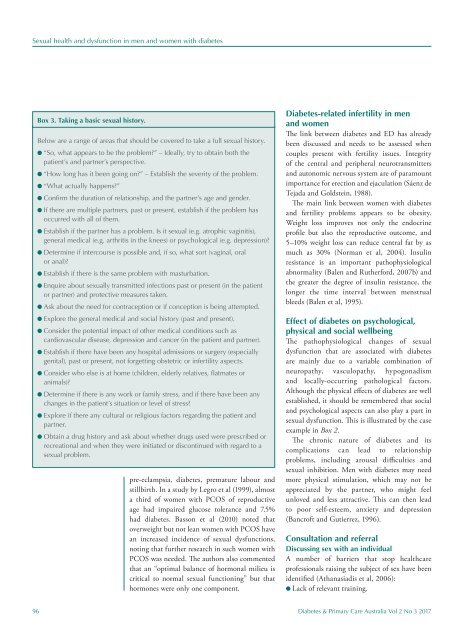DPCA 2-3_entire_v3
Create successful ePaper yourself
Turn your PDF publications into a flip-book with our unique Google optimized e-Paper software.
Sexual health and dysfunction in men and women with diabetes<br />
Box 3. Taking a basic sexual history.<br />
Below are a range of areas that should be covered to take a full sexual history.<br />
l “So, what appears to be the problem?” – Ideally, try to obtain both the<br />
patient’s and partner’s perspective.<br />
l “How long has it been going on?” – Establish the severity of the problem.<br />
l “What actually happens?”<br />
l Confirm the duration of relationship, and the partner’s age and gender.<br />
l If there are multiple partners, past or present, establish if the problem has<br />
occurred with all of them.<br />
l Establish if the partner has a problem. Is it sexual (e.g. atrophic vaginitis),<br />
general medical (e.g. arthritis in the knees) or psychological (e.g. depression)?<br />
l Determine if intercourse is possible and, if so, what sort (vaginal, oral<br />
or anal)?<br />
l Establish if there is the same problem with masturbation.<br />
l Enquire about sexually transmitted infections past or present (in the patient<br />
or partner) and protective measures taken.<br />
l Ask about the need for contraception or if conception is being attempted.<br />
l Explore the general medical and social history (past and present).<br />
l Consider the potential impact of other medical conditions such as<br />
cardiovascular disease, depression and cancer (in the patient and partner).<br />
l Establish if there have been any hospital admissions or surgery (especially<br />
genital), past or present, not forgetting obstetric or infertility aspects.<br />
l Consider who else is at home (children, elderly relatives, flatmates or<br />
animals)?<br />
l Determine if there is any work or family stress, and if there have been any<br />
changes in the patient’s situation or level of stress?<br />
l Explore if there any cultural or religious factors regarding the patient and<br />
partner.<br />
l Obtain a drug history and ask about whether drugs used were prescribed or<br />
recreational and when they were initiated or discontinued with regard to a<br />
sexual problem.<br />
pre-eclampsia, diabetes, premature labour and<br />
stillbirth. In a study by Legro et al (1999), almost<br />
a third of women with PCOS of reproductive<br />
age had impaired glucose tolerance and 7.5%<br />
had diabetes. Basson et al (2010) noted that<br />
overweight but not lean women with PCOS have<br />
an increased incidence of sexual dysfunctions,<br />
noting that further research in such women with<br />
PCOS was needed. The authors also commented<br />
that an “optimal balance of hormonal milieu is<br />
critical to normal sexual functioning” but that<br />
hormones were only one component.<br />
Diabetes-related infertility in men<br />
and women<br />
The link between diabetes and ED has already<br />
been discussed and needs to be assessed when<br />
couples present with fertility issues. Integrity<br />
of the central and peripheral neurotransmitters<br />
and autonomic nervous system are of paramount<br />
importance for erection and ejaculation (Sáenz de<br />
Tejada and Goldstein, 1988).<br />
The main link between women with diabetes<br />
and fertility problems appears to be obesity.<br />
Weight loss improves not only the endocrine<br />
profile but also the reproductive outcome, and<br />
5–10% weight loss can reduce central fat by as<br />
much as 30% (Norman et al, 2004). Insulin<br />
resistance is an important pathophysiological<br />
abnormality (Balen and Rutherford, 2007b) and<br />
the greater the degree of insulin resistance, the<br />
longer the time interval between menstrual<br />
bleeds (Balen et al, 1995).<br />
Effect of diabetes on psychological,<br />
physical and social wellbeing<br />
The pathophysiological changes of sexual<br />
dysfunction that are associated with diabetes<br />
are mainly due to a variable combination of<br />
neuropathy, vasculopathy, hypogonadism<br />
and locally-occurring pathological factors.<br />
Although the physical effects of diabetes are well<br />
established, it should be remembered that social<br />
and psychological aspects can also play a part in<br />
sexual dysfunction. This is illustrated by the case<br />
example in Box 2.<br />
The chronic nature of diabetes and its<br />
complications can lead to relationship<br />
problems, including arousal difficulties and<br />
sexual inhibition. Men with diabetes may need<br />
more physical stimulation, which may not be<br />
appreciated by the partner, who might feel<br />
unloved and less attractive. This can then lead<br />
to poor self-esteem, anxiety and depression<br />
(Bancroft and Gutierrez, 1996).<br />
Consultation and referral<br />
Discussing sex with an individual<br />
A number of barriers that stop healthcare<br />
professionals raising the subject of sex have been<br />
identified (Athanasiadis et al, 2006):<br />
l Lack of relevant training.<br />
96 Diabetes & Primary Care Australia Vol 2 No 3 2017
















